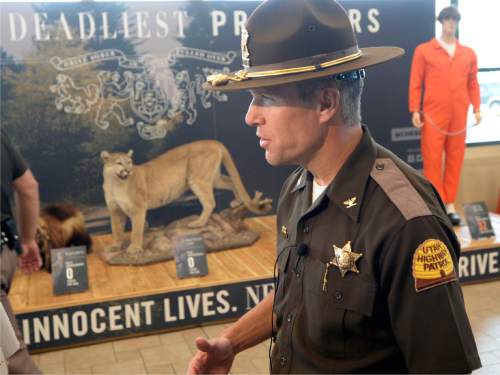This is an archived article that was published on sltrib.com in 2015, and information in the article may be outdated. It is provided only for personal research purposes and may not be reprinted.
Deaths from drunken driving in Utah nearly doubled last year — rising from 23 to 45.
That is the highest in more than a decade, according to an annual report on driving under the influence given Wednesday to the Legislature by the Utah Commission on Criminal and Juvenile Justice.
Those 45 drunken driving deaths in 2015 accounted for nearly 18 percent of all highway fatalities, also the highest share in more than a decade.
The increases are for alcohol-related DUIs, not those involving other drugs, from marijuana to improperly used prescription medicines.
Ironically, Mary Lou Emerson, director of the Utah Substance Abuse Advisory Council, said the state had focused more in recent years on the increasing numbers of drug-related DUIs — but they had an 18 percent drop last year, from 45 to 38.
In some recent years, drug-related DUIs were "getting to be double that of the alcohol-related fatalities," Emerson said, "and we attributed that to a lot of the prescription-drug problems and people not understanding that they need to pay attention to the legally prescribed substances … that made them drowsy."
While much attention had shifted to drug-related DUIs, deaths from drunken driving suddenly surpassed them last year — leading some officials and lawmakers to call Wednesday for a renewal and expansion of efforts from education to enforcement and treatment to attack the problem.
"We've got some massive red flags" now about drunken driving, Rep. David Lifferth, R-Eagle Mountain, told the Transportation Interim Committee. "These should get our attention. We should be aware of these and have policies to address them."
Some of the worrisome data about drunken driving presented Wednesday include:
• Deadly drunken driving crashes in Salt Lake County more than quintupled last year, from three to 17. That was more than in the previous three years combined and resulted in 20 deaths.
• The total number of alcohol-related crashes statewide increased last year from 1,736 to 2,128, up 23 percent. That was the highest since 2008.
• In the past, about 80 percent of DUI-related deaths usually were drunken drivers themselves or their passengers. Last year, that decreased to 67 percent.
• Of the 45 fatalities from drunken driving last year, 22 were drunken drivers; eight were passengers of the drunken driver; nine were occupants of other vehicles; five were pedestrians; and one was a bicyclist.
• Seven of the 37 drunken drivers involved in fatal crashes — 19 percent — had a previous DUI conviction in the past five years.
• Besides the 45 deaths from drunken driving, four other deaths occurred in accidents where a driver had been drinking — but his or her blood alcohol level did not exceed the 0.08 legal limit. Emerson said that may lead officials to consider whether the 0.08 limit should be lowered.
Utah Highway Patrol Superintendent Daniel Fuhr said one reason that drunken-driving deaths may have been higher last year is that crashes tended to involve more passengers, and each crash tended to hurt more victims.
Emerson and Ron Gordon, executive director of the Utah Commission on Criminal and Juvenile Justice, called for a multi-pronged approach to combat drunken driving — everything from education campaigns to increased enforcement and more treatment for those with drinking problems.
"The vast majority" of people arrested for DUI "are first-time offenders," Emerson said, about 70 percent of the total. She said increased public-awareness campaigns could help with prevention.
She also encouraged renewed encouragement of designated-driver programs by merchants who offer alcohol. She noted that during special DUI checkpoints and enforcement blitzes, officers identified more than 1,146 designated drivers — showing such programs are having success already.
DUI arrests decreased again last year, continuing a long downward trend — falling by 99 statewide to 10,802. Emerson said her group may push for funding more DUI checkpoints and saturation patrols, calling those the most effective strategies to enforce DUI laws.
Of the 10,802 DUI arrests made in Utah between July 1, 2014, and June 30, 2015, 1,344 were made during special DUI enforcement blitzes, saturation patrols and sobriety checkpoints.
"It really takes a multi-pronged approach to address this problem," Gordon said. "We have to address all of them."
The report also contained a variety of other data about DUIs, including:
• Almost 11 percent of those arrested were under the legal drinking age of 21. The youngest person arrested was 14 years old; the oldest was 87.
• The average blood-alcohol content for those arrested was 0.15, nearly double the legal limit of 0.08. The highest for anyone arrested was 0.41, more than five times the legal limit.
• Salt Lake, Davis, Weber and Utah counties account for nearly 71 percent of all DUI arrests.
• While Utah's population has grown rapidly, the DUI arrest rate had declined steadily — dropping about 37 percent since fiscal 2009.
• About 19 percent of DUI arrests are for a second offense, 7 percent for a third and 4 percent for a fourth or subsequent offense.
• Three of every four people arrested for DUI were male.







